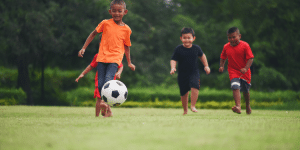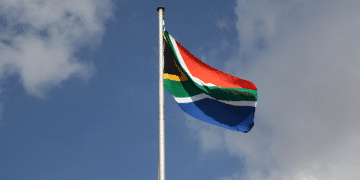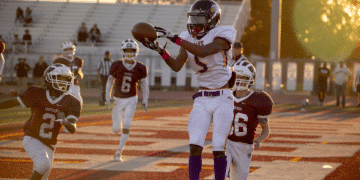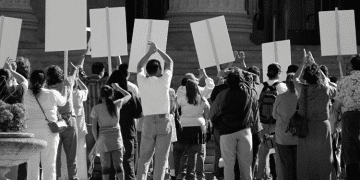Groundbreaking School Sports Initiative: South Africa Launches Nationwide Access Transformation Program
A Historic Partnership for Educational Sports
Signing of Groundbreaking MoU
South Africa recently took a monumental step towards transforming school sports by signing a historic Memorandum of Understanding (MoU) between the Minister of Sport, Arts, and Culture, Gayton McKenzie, and the Minister of Basic Education, Siviwe Gwarube.
This MoU signifies a deliberate move to enhance access to sports and cultural programs within the school system.
Focus is particularly on leveling the playing field for children across rural and disadvantaged areas to ensure they have the same opportunities to thrive in sport and the arts as their urban counterparts.
Key Outcome of the 2023 School Sport Indaba
The signing of this MoU is a direct result of the discussions and collaborations at the 2023 School Sport Indaba.
This comprehensive gathering of stakeholders aimed to create a framework for developing school sports at the grassroots level.
The Indaba provided a platform for various voices to be heard and contributed to the formation of actionable strategies.
It was during these discussions that the need for an integrated, nationwide approach to school sports became apparent.
The MoU establishes a collaborative framework between the Department of Basic Education and the Department of Sport, Arts, and Culture to implement nationwide extracurricular programs.
This is not just about creating an agreement on paper but translating that agreement into visible, impactful actions. It’s about harnessing the power of coordinated efforts to transform dreams into reality for young South Africans.
Alignment with Government of National Unity’s Vision for Equal Access
This monumental agreement aligns perfectly with the Government of National Unity’s vision under President Cyril Ramaphosa’s leadership.
The vision aims for equitable access to opportunities for all South Africans, with a specific focus on underprivileged communities.
By addressing the discrepancy in access to sports facilities between affluent and disadvantaged schools, this initiative commits to a future where no child is left behind due to their socio-economic background.
The MoU also envisions an approach where facilities are shared among multiple schools.
This strategy helps ensure that even those in the most remote areas can benefit from world-class sports facilities, coaching, and equipment.
By involving private businesses, NGOs, and civil society, the initiative encourages a collective effort to bridge the gap, ensuring that every young person has a fair shot at unlocking their full potential.
With this collective accord, South Africa is set to make significant strides in nurturing talent and boosting transformation within the realms of both sport and culture.
This coherent effort sets the stage for upcoming initiatives that will further solidify the impact of this pioneering partnership.

Breaking Down Barriers in School Sports
Providing Access to Sports Facilities
One of the primary goals of the new partnership between South Africa’s Department of Basic Education and the Department of Sport, Arts, and Culture is to ensure that every child, regardless of their background, has access to sports facilities. This initiative targets rural and township areas, which have historically been underserved.
Many children in these areas have not had the opportunity to participate in organized sports due to a lack of facilities and resources.
This initiative aims to change that by building and improving sports facilities in these communities.
The plans include multi-sport arenas that can host various activities, ensuring that multiple schools can share these facilities and benefit from them.
Reducing Reliance on Private Schools
Historically, South Africa has relied heavily on private schools for developing sports talent.
While these schools have produced many top athletes, this reliance has created a gap, where children from disadvantaged backgrounds have limited opportunities to showcase and develop their talents.
By providing equal access to facilities, coaching, and equipment, this program aims to level the playing field.
The talent pool for national teams will no longer be predominantly drawn from private schools but will include a more diverse representation of the country’s youth.
Shared Facilities Strategy
A key component of the program is the strategy of shared facilities among multiple schools.
Rather than every school having to build its own sports complex, which can be both costly and impractical, schools within a region will share state-of-the-art facilities.
This approach maximizes the use of resources and ensures that facilities are used more efficiently.
It encourages community involvement and fosters a sense of unity among schools.
The facilities will not only cater to a variety of sports but also provide spaces for arts and cultural activities, ensuring a holistic approach to extracurricular development.
By breaking down these barriers, the Government of National Unity aims to transform the sports landscape.
Children from all backgrounds will have the chance to pursue their passions, which is a significant step towards achieving equal opportunities and representation in South African sports.
This groundbreaking effort sets the stage for further initiatives that will build on these foundations, ensuring long-term, sustainable development and transformation in the nation’s sports programs.
Collaborative Framework for Implementation
The success of any wide-reaching initiative lies in the strength of its partnerships.
The recent collaboration between South Africa’s Department of Basic Education and the Department of Sport, Arts, and Culture is a testament to this principle.
This partnership not only showcases the power of teamwork but also marks a crucial step towards transforming access to sports facilities nationwide.
An All-Encompassing Partnership
A partnership of this magnitude involves collaboration at multiple levels.
By uniting their efforts, these departments aim to provide equal opportunities to children across the country, leaving no community behind.
The commitment to offering shared facilities among schools is a strategic decision that maximizes resources and fosters a spirit of community.
Schools, especially those in rural and underprivileged areas, will no longer struggle in isolation. Instead, they will benefit from shared resources and initiatives that are designed to uplift all students uniformly.
Driving Collective Action
The framework for this initiative is expansive, incorporating multiple stakeholders to ensure its success.
Government agencies alone cannot sustain such a broad initiative.
Therefore, the involvement of private businesses, NGOs, and civil society is essential.
Companies can contribute funding and other resources, NGOs can help with implementation and outreach, and civil society can bring invaluable grassroots support.
Each group plays a unique and critical role, creating a robust support network for the new sports programs.
This multi-stakeholder approach is crucial for maintaining the momentum and ensuring that the program reaches every corner of the nation.
Engagement from diverse sectors of society ensures that the facilities and programs are not only built but are also sustainable in the long run.
Extracurricular and Sports Program Rollout
The nationwide rollout of extracurricular and sports programs aims to level the playing field. Students from various backgrounds will have access to facilities and coaching that can propel them toward excellence in sports.
By standardizing the availability of these resources, the initiative addresses the historical reliance on private schools for sports talent development.
Instead of a few privileged schools serving as talent feeders, a broader range of students will now showcase their abilities.
These programs will offer more than just physical education; they will cultivate discipline, teamwork, and leadership skills.
As students engage in diverse sports and cultural activities, they will be better prepared for future challenges, both on and off the field.
This initiative reflects an ambitious yet actionable vision for the future of South African sports.
It not only aims to discover new talent but also to nurture it, ensuring that success is within reach for every child, no matter their background.
With this commitment to equality and fair access, the foundation is set for a bright and inclusive future.
As the journey continues, the focus will shift towards identifying potential talent and laying the groundwork for sustained excellence in South African sports.
Vision for Olympic Success
The signing of the landmark MoU between the Minister of Sport, Arts, and Culture, Gayton McKenzie, and Basic Education Minister, Siviwe Gwarube, marked the beginning of an ambitious initiative aimed at transforming South African sports on a global scale—Project 300.
This initiative represents an ambitious vision to see 300 South African athletes compete at the Los Angeles Olympic Games. It aims not only to bolster national pride but also to inclusively nurture talent across the diverse South African landscape.
Introduction to Project 300
Project 300 is a comprehensive initiative designed to identify, nurture, and develop young athletic talent from all communities within South Africa.
The cornerstone of the project lies in its inclusive approach—ensuring that no child, regardless of their background or location, is deprived of the opportunity to shine.
Central to the scheme is the identification of raw talent within South Africa’s numerous schools—particularly those in rural and disadvantaged areas.
By shifting focus from the traditional reliance on private schools, Project 300 seeks to unearth hidden gems and offer every promising athlete a platform to develop.
| Key Focus | Before Project 300 | After Project 300 |
|---|---|---|
| 🌍 Talent Identification | Limited to urban areas, with few scouts | Nationwide approach, with scouts working directly with schools in both urban and underprivileged areas |
| 🏋️♂️ Training Programs | Generic, one-size-fits-all training | Tailored training for individual athletes, focusing on their unique needs and strengths |
| 🏅 Coaching and Mentorship | Limited access to professional coaches and mentors | Access to top-tier coaches, mentors, and sports professionals |
| 🔍 Talent Assessment | Occasional evaluations with limited tracking | Regular talent assessments, with detailed progress evaluations and improvements tracked |
| 💪 Values and Development | Focus on raw athletic talent only | Incorporates values of discipline, teamwork, and perseverance alongside athletic skill development |
Transforming South African Sports Representation
The ultimate goal of Project 300 extends beyond mere participation; it is about transforming the face of South Africa’s sports representation globally.
By democratizing access to training facilities and high-quality coaching, the initiative aims to build a more inclusive national team that truly reflects the country’s diversity.
The involvement of private businesses, NGOs, and civil society is critical to achieving this transformation.
Their support in funding, providing infrastructure, and offering expertise enhances the program’s reach and impact.
The unity forged between the Department of Basic Education and the Department of Sport, Arts, and Culture, supported by the broader societal framework, not only promises Olympic success but also aims to inspire a new generation of athletes and sports enthusiasts.
Project 300 is just one part of South Africa’s broader strategy to engender long-term, sustainable development in school sports.
The commitment to nurturing young talent today will shape the national teams of tomorrow, yielding a sports culture that every South African can be proud of.
Future Impact and Leadership Commitment
Dedication to Long-term Transformation
The Government of National Unity, under the leadership of President Cyril Ramaphosa, has made a strong commitment to revolutionizing school sports in South Africa.
This transformation is not a fleeting endeavor but a cornerstone of the country’s strategy to foster equitable access and opportunity.
With a particular focus on rural and disadvantaged areas, the government aims to dismantle existing barriers and nurture talent from every corner of the nation.
This dedication is crucial in demonstrating an unwavering commitment to the social and athletic development of young South Africans.
Cultivating Future Leaders
A key component of this initiative is the sustainable development of school sports programs, which is seen as a vital nurturing ground for future leaders.
Sport is not just about physical fitness; it plays a fundamental role in teaching discipline, teamwork, and leadership—qualities essential for the growth and success of individuals and communities alike. B
y investing in these programs, the government is actively sowing the seeds for a prosperous and unified future, where every child has the opportunity to reach their full potential regardless of their background.
Commitment to Sustainable Development
Sustainability is at the heart of this transformative journey.
Through collaborative efforts with various stakeholders, including private businesses, NGOs, and civil society, the government ensures that these changes are not only implemented but also maintained and built upon over time.
This multifaceted strategy includes the efficient use of shared facilities, consistent funding, and ongoing community engagement, ensuring the long-term viability of sports programs and facilities across the nation.
As South Africa strives to achieve its ambitious goals, the government’s leadership is set to usher in a new era of inclusivity and opportunity in school sports.
This initiative marks a significant step towards an equitable future—one that will shape the nation’s sports representation both domestically and on the global stage.





